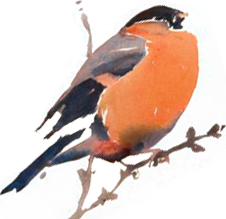Although much is known about the biology of the birds that live in Scotland, it is useful to have up-to-date information on the status of populations, ideally followed up with an understanding of the reasons for any change. Armed with such knowledge, conservation measures may be implemented. Information on bird migrations and habitat requirements can also be helpful for the conservation of species, to ensure that suitable sites in different regions are available at particular times of the year. The requirements for further knowledge are more pertinent nowadays, given that the world is experiencing biodiversity loss as a consequence of habitat loss and an increase in global temperature. There is also a place to fulfil scientific curiosity that may have no bearing on conservation need, because new findings may lead to unexpected routes in the study of birds.
The biology and status of birds in Scotland has been reviewed in three major accounts: The Birds of Scotland (Baxter & Rintoul 1953), Birds in Scotland (Thom 1986) and The Birds of Scotland (Forrester et al. 2007). In the latter publication, the authors of the individual species' accounts offered their perspectives on gaps in our knowledge of regularly occurring species, recognising that there is still much to learn about Scottish birds.
For a discussion of our knowledge gaps, including examples, see "What we don't know about birds in Scotland" in Scottish Birds 43: 118-131 (Summers, Lewis, Hunter 2023).
Many gaps have been filled since the publication of The Birds of Scotland; the table below highlights where future research effort for each species could be devoted. We hope that this page will be a port of call for those who are interested in carrying out studies of birds in Scotland. We also hope that the table can be interactive through additions, expansions and deletions of topics as knowledge develops. Many areas for further study are within the abilities of keen amateur birdwatchers and bird ringers to contribute to our understanding of particular species, either working as individuals, groups, or collaborating with professionals. Note that the table is read-only, but we will shortly publish a process for submitting updates.
Click on the 'v' button in a column heading to sort on that column, or to filter the values shown. The use of filters is explained in more detail below.
This resource allows you to search for known knowledge gaps for species of birds that occur regularly in Scotland. You can search a number of different ways.
To view knowledge gaps for a particular species, you can filter the English Name or Scientific Name column to show the species you are interested in. Hit the filter button (the small 'v' next to the column title) and click in the 'select all' box to uncheck all of the species. You can then search down the list for the species you are interested in, click on the checkbox next to that species, and press 'OK'. This will return all gaps for the species you have chosen. Details pertaining to the known gaps are contained in the Gap Definition column.
To search for knowledge gaps for a particular family (for example Ducks,) you can filter the Gap Family column in the way described above. This returns all gaps for all species represented in the database within that family. Similarly, you can search for Functional Group in the same way. Functional groups are groups of families of birds, for example, the functional group 'Wildfowl' comprises Ducks, Geese and Swans.
Note that to filter effectively through any column, you must make sure all other filters are off. You can remove any filters that are in place by clicking on the filter button, hitting the 'select all' option at the top of the list, and pressing 'OK'.
You can also search the database for all species that have knowledge gaps related to a particular area. For example, filtering the Gap Family column for 'population' will return all rows of data where a population related gap is listed for a species. You can refine further (and independent to filtering by Gap Family) by filtering the Gap Category column. Within the gap family 'population' this breaks knowledge gaps down further, into categories such as Survival, Summer, Winter, Sub-species, Immigration and more.



